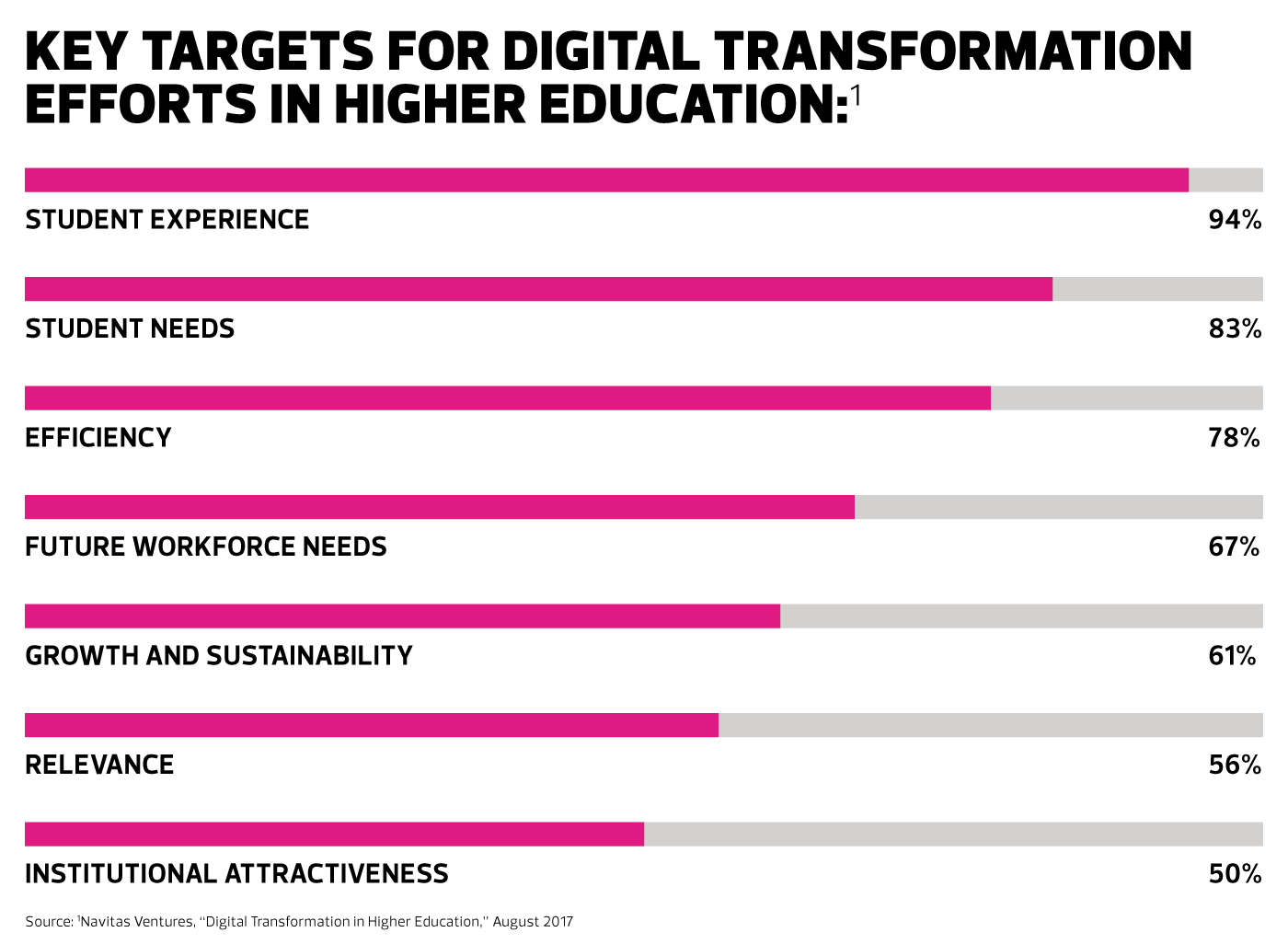Once higher education leaders have a firm grasp of what digital transformation is, why it matters and how IT professionals can help lead the way, the next step is to understand the challenges, areas of opportunity and how to get ready.
Experts Joseph Moreau, vice chancellor of technology at Foothill-De Anza Community College District, Josie DeBaere, director of technology architecture at Boston University, and Brendan Aldrich, chief data officer at California State University offer some advice on how to direct a smooth digital transformation.
MORE FROM EDTECH: Check out how digital transformation initiatives are moving forward in higher education.
EDTECH: What are the major challenges with regard to digital transformation initiatives?
MOREAU: Fear. There’s fear that people are going to lose their jobs: “You’re going to digitize whatever this thing is that I contribute to and you’re no longer going to need me.” There’s fear that the distance between students and the people they interact with in institutions is going to be cavernous, and we’re going to depersonalize and dehumanize our institutions.
The other big thing that is an inhibiting factor for digital transformation is the ability for people to wrap their heads around the concept. For institutions to make any progress, they really do have to find out how to deconstruct it. Where do students complain that they’re not being served as well as they believe they should be? Where are we not retaining students as effectively as we might be? Where are employees saying the workload is tripling? Maybe those are the places we can start to look at digital transformation.
Some very progressive institutions have filled positions with titles such as chief innovation officer, so they actually have somebody on their campus who owns this. But in the absence of some specifically designated leader, it’s not very clear whose job it is. This is such a big thing. Going back to that old story about how to eat an elephant — where do you start? I think we’ve done a pretty good job with the EDUCAUSE digital transformation working group to help people understand where they can start with this. What is the low-hanging fruit? What have other places done? How did it work out?

DEBAERE: To make digital transformation a reality, you have to introduce many new technologies. If you don’t manage how you bring them into the organization, it can result in chaos if some of these technologies fail to work together. It’s like the chaos that would ensue in a city if there was no urban planning, no zoning regulations, no street planning around where new buildings can be erected.
You want to promote standardization of data integration so that various complex systems can interoperate without having to be from one vendor. You want to consolidate services so you don’t have duplication of effort. You want to have agility. For this, you need an enterprise architecture program, which we introduced at BU in 2014.
The other challenge is with all this Big Data, what does that mean for our responsibilities? What data is it OK to collect? At Boston University, we’re implementing a data governance program. It looks at not only data security, but also how to govern the use of data. We want an organized, coordinated approach. We don’t want it to be “This data belongs to this department and this data belongs to this department.”
ALDRICH: I think the workforce and the cultural aspects will be the most challenging for many institutions. Within IT, we’ve been dealing with technology over the years — specifically the changes, advances and giant leaps that technology has made — so I don’t necessarily think it’s a challenge of technology. I think for those of us in IT, the workforce challenges of being able to better train our internal workforce to more successfully partner with and collaboratively engage others in the institution is where we should focus. Culturally, the challenge may be making sure that as you’re engaging, you’re doing it transparently: building trust, delivering successfully, building those bridges and getting buy-in from other areas.
MORE FROM EDTECH: See how universities are facing cloud migration challenges.
EDTECH: Which business processes and insights are good candidates for digital transformation?
DEBAERE: Leveraging Big Data. If we can collect more data, we can get more information on what students are doing and what kind of people we are trying to attract to our institution. Can we optimize our bulk buys? To what extent can we operate more economically or operate in a more favorable way financially by using predictive analytics?
Other initiatives are related, to a large extent, to student satisfaction. One weakness of many higher education institutions is that when students are onboarded, they go through admissions, then they register, then they choose their housing preferences, then they do the financial aid, and basically they’re put through this mill of having to go through five different departments.
Look at Netflix. When I was 20 years old, if I wanted to watch a movie, I would go to the video store and walk around and pick a video, then I’d pay for the video, then I’d take the video home, then I’d put it in my VCR and watch it, then I’d take it out and then I’d bring it back to the video store. Netflix took all those things and removed the friction between them. I think that’s a way we can transform our higher education institutions. We can make them more student-friendly by removing that kind of friction.
MOREAU: We have to decide where we want to advance digital transformation in our organizations, because we may decide that we don’t want to advance it everywhere. We’ve got to have that capability of looking at ourselves and asking if this is really the best way to accept admissions applications. Could we say, “We’re only going to ask you for five pieces of information? Of course, we need to get this other information from you, because the law says we have to, but it doesn’t say we have to get it from you directly or all at once, so maybe we’ll get it from the DMV or your high school.”
For example, you might decide that student orientation is not something you necessarily want to transform in the same way you transformed financial aid. You might say, no, it’s critically important to the values of our institution that student orientation is focused on one-on-one engagement and personal contact, and inserting some level of technology into that just for the sake of efficiency might degrade the quality of that experience.

EDTECH: How can IT departments prepare their campuses for digital transformation?
ALDRICH: Today we’re seeing technology that’s being brought in by academic affairs, by student success, by advising — by lots of areas in the institution that were traditionally not technology oriented. You have to ask the question: Is it because they felt IT was not responsive enough in being able to provide that? Digital transformation gives us an opportunity to start rethinking culturally about how we interact with the institution. Do we have the resources to engage more successfully with our partners across the campus? If not, what can we do to start moving in that direction so we can be better partners in the future? Partnership is the key here: We must work with all of the departments as equals in crafting digital transformation.
You’ve got to reach out. You’ve got to engage. You’ve got to communicate. And after you’ve done that, you need to deliver. That kind of communication and bridge-building are the kinds of things that every IT team in education can start doing today.
MOREAU: The biggest thing IT departments can do to support their campuses is work as hard as they can to rebrand themselves as a strategic partner and not as a utility, a gatekeeper, a naysayer or any of those other negative connotations that we frequently have around campus IT departments.
Digital transformation is about people. It’s about service. It’s about instruction. It’s about opportunity. It’s about equity. The technology part is almost inconsequential. It’ll work itself out. It’ll always change. But if we haven’t thought through what we’re trying to do with people and for people, on their behalf as educators, then the technology’s kind of pointless.
To understand how universities may want to start approaching digital transformation, check out "Digital Transformation: The Quest to Rethink Campus Operations."










